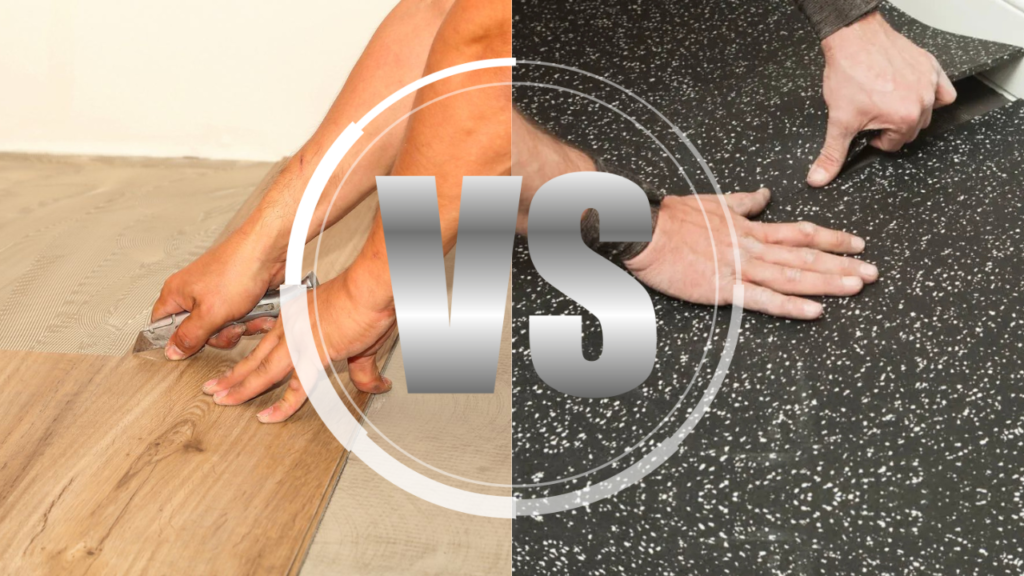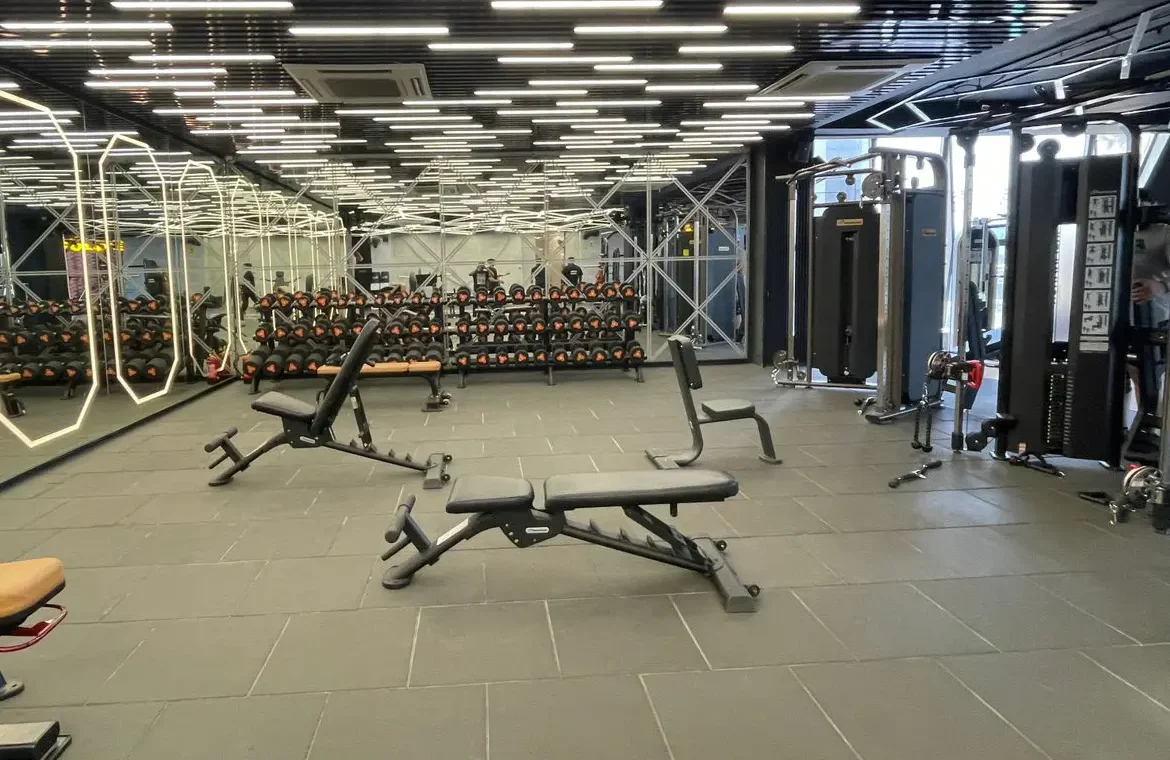When it comes to choosing the right gym flooring material for your gym, two of the most popular materials are rubber and vinyl. Both options have unique benefits, but how do you decide which one is right for your gym? Whether you’re setting up a home gym or outfitting a commercial fitness center, the decision should be based on several factors, such as durability, comfort, maintenance, and cost.
At Fab Flooring Dubai, we understand how important it is to make an informed decision when choosing your gym floor. In this blog post, we’ll compare rubber and vinyl flooring, helping you determine which one best suits your needs.
Rubber Flooring: Strength and Durability
Rubber flooring is widely known for its durability and shock-absorbing qualities, making it an excellent choice for high-traffic areas and spaces with heavy equipment. Here are some key benefits of rubber flooring:
1. Durability and Longevity
Rubber is one of the most durable gym flooring materials available for gym flooring. It is resistant to impact, wear, and tear, which makes it ideal for heavy weightlifting areas or places where equipment like treadmills or machines are used frequently. It can handle the intense pressure and wear that comes from heavy use without cracking or denting, ensuring it lasts for many years.
2. Shock Absorption and Safety
Rubber flooring provides excellent shock absorption, reducing the risk of injury during high-impact activities such as jumping, running, or weightlifting. The cushioning effect helps protect your joints and muscles, making it a safer choice for intense workouts. It also minimizes the sound of weights dropping, making it a quieter option for gyms.
3. Low Maintenance
Rubber floors are relatively easy to clean and maintain. Regular sweeping or vacuuming and occasional mopping with a mild cleaner is usually enough to keep the gym flooring in great condition. The material is also resistant to stains, so it’s easier to maintain its appearance.
4. Moisture and Slip Resistance
Rubber floors are naturally moisture-resistant, which is an essential feature for gym environments where sweat or water can accumulate. Additionally, rubber flooring offers excellent slip resistance, providing a secure and non-slip surface even when wet, making it an excellent choice for cardio areas or workout zones with high-intensity movements.
5. Eco-Friendly Option
Rubber flooring is often made from recycled materials, making it an environmentally friendly option. If sustainability is important to you, rubber flooring is a great choice for reducing your gym’s environmental impact.
Are you looking for Rubber-Flooring ?
Vinyl Flooring: Stylish and Affordable
1. Cost-Effective
One of the most significant advantages of vinyl flooring is its affordability. It is generally more cost-effective than rubber flooring, making it a great choice for gyms on a budget. If you need to cover a large space without breaking the bank, vinyl is a solid option that provides both value and performance.
2. Aesthetic Appeal
Vinyl flooring is known for its sleek, modern look. It comes in various designs, colors, and finishes, including wood, stone, and tile looks, which can complement any gym decor. This makes it a popular choice for those who want an upscale look without the high price tag of natural materials. It’s perfect for creating a clean, professional, and visually appealing environment.
3. Easy Installation
Vinyl flooring is relatively easy to install compared to other flooring options. It comes in large rolls, planks, or tiles, and can often be installed without the need for adhesives or glue, making it a more DIY-friendly option for home gyms or commercial spaces.
4. Comfort and Cushioning
While vinyl does not provide as much shock absorption as rubber, it still offers comfort for lower-impact activities like yoga, pilates, and general fitness exercises. Vinyl flooring is often cushioned, providing a softer surface for standing or floor-based workouts.
5. Low Maintenance
Like rubber flooring, vinyl floors are easy to maintain. They are resistant to stains, dirt, and moisture, and can be cleaned with minimal effort. Regular sweeping or vacuuming followed by occasional mopping is usually all that’s needed to keep your vinyl floor looking fresh and new.
Key Differences Between Rubber and Vinyl Flooring
Now that we’ve looked at the individual benefits of rubber and vinyl flooring, it’s important to compare them side by side. Here’s a breakdown of the key differences:

| Feature | Rubber Flooring | Vinyl Flooring |
|---|
| Durability | Highly durable and resistant to impact and wear | Durable but may dent or wear under heavy loads |
| Shock Absorption | Excellent shock absorption for high-impact areas | Moderate cushioning for low-impact activities |
| Maintenance | Easy to clean, low-maintenance | Low-maintenance, easy to clean |
| Cost | More expensive than vinyl | More affordable and budget-friendly |
| Aesthetic Options | Variety of colors and textures, but limited designs | Wide range of stylish designs and finishes |
| Slip Resistance | Excellent slip resistance, even when wet | Good slip resistance but not as high as rubber |
| Moisture Resistance | Naturally moisture-resistant | Highly moisture-resistant |
| Eco-Friendliness | Often made from recycled materials | Less eco-friendly than rubber |
Which Flooring Material is Right for You?
When deciding between rubber and vinyl flooring for your gym, consider the following:
For Heavy Lifting and Intense Workouts: If your gym involves heavy weightlifting or high-impact activities, rubber flooring is likely the better choice due to its superior durability and shock absorption. It’s perfect for areas where weights are dropped frequently or where there’s a lot of intense movement.
For Budget-Conscious or Aesthetic Spaces: If you’re on a budget or want a sleek, stylish look for your gym, vinyl flooring might be the better option. It provides a comfortable surface for lighter activities and comes in a variety of colors and designs, making it ideal for commercial gyms that want a high-end look without the price tag.
For Home Gyms or Low-Impact Areas: For a home gym flooring, where the intensity may be lower, vinyl can offer comfort and ease of maintenance. However, for areas like a dedicated weight room or high-impact workout zones, rubber flooring would be more beneficial.
Do you want to know about : Maintaining Gym Flooring
Conclusion
Choosing the right gym flooring for your gym ultimately depends on your specific needs and budget. Rubber flooring is the go-to choice for durability, safety, and shock absorption, making it ideal for high-impact workouts and heavy equipment. On the other hand, vinyl flooring offers a cost-effective, stylish, and low-maintenance solution that’s perfect for lighter activities and aesthetically-driven spaces.
At Fab Flooring Dubai, we offer both rubber and vinyl flooring solutions, tailored to meet the unique needs of your gym flooring . Whether you’re outfitting a commercial gym, home gym, or yoga studio, our team can help you choose the right flooring option to create a safe, comfortable, and visually appealing environment.
Contact us today for expert advice on gym flooring and to explore our wide range of high-quality options designed to suit any gym type and budget!
-
What are the main differences between rubber and vinyl gym flooring?
Rubber is known for its high impact absorption, slip resistance, and durability under heavy loads. Vinyl, on the other hand, offers a smoother surface, aesthetic versatility, and easier cleaning—making it better suited for light workouts or multi-use rooms.
-
Which flooring is more durable for high-impact workouts?
Rubber flooring outperforms vinyl in durability, especially in weightlifting zones, CrossFit areas, and high-intensity workout spaces. It handles dropped weights and intense foot traffic without tearing or denting.
-
Is vinyl gym flooring suitable for heavy equipment areas?
Not ideal. Vinyl is prone to denting or warping under excessive pressure or weight, making it less suited for power racks, barbells, and other heavy gym equipment.
-
Which material offers better shock absorption?
Rubber excels at shock absorption. It protects joints, reduces fatigue, and minimizes the risk of injury from impact-heavy exercises like jumping or Olympic lifts.
-
Which flooring is easier to clean and maintain?
Vinyl is easier to clean due to its smooth, sealed surface. It resists stains and moisture more effectively than rubber, making it a good choice for studio-style or personal training areas.
-
How do the costs compare between rubber and vinyl flooring?
Vinyl tends to be more budget-friendly initially, but rubber provides greater longevity and value over time—especially in high-performance gym settings where wear and tear are significant.
-
Is rubber or vinyl more eco-friendly?
Rubber flooring—especially recycled rubber—is considered more sustainable. Many manufacturers use post-consumer rubber, reducing landfill waste and promoting green practices.
-
Which material offers better noise and vibration control?
Rubber is the superior choice for sound dampening and vibration absorption. It reduces noise from weights, cardio machines, and foot traffic more effectively than vinyl.
-
Can either flooring type be customized for branding or design?
Both materials can be customized with colors, logos, and layout designs. However, vinyl allows more intricate visuals and printed finishes, while rubber offers bolder, more rugged branding options.
-
Which flooring is better for home gyms vs. commercial gyms?
Rubber is better suited for commercial gyms due to its resilience, safety features, and durability. Vinyl can work well in home gyms or hybrid spaces where aesthetics and easy cleaning take priority over heavy use.

